MARKET OVERVIEW
The Indonesia Foodservice Sweetened Condensed Milk is one of the largest segments of the industry with potential for local and international manufacturing and distribution firms. It is because of the importance of sweetened condensed milk in the preparation of many Indonesian beverages and desserts that this market has emerged over time. It’s an essential ingredient among cafes, street vendors, and restaurants alike because of its shelf life, rich flavor, and sweetness-enhancing capability to traditional recipes. Through the years of its application into native dishes including es teler, kopi susu, and martabak, sweetened condensed milk remains central in carrying off flavors unique to Indonesia’s culinary culture.
Indonesia’s foodservice industry-the market for sweetened condensed milk-consumers increasingly demand quick, indulgent, and affordable products. Street vendors, cafes, and high-end restaurants demand sweetened condensed milk not just for price factors but mainly for flexibility. This dairy should be used as a topping or even as a core ingredient to be blended with other ingredients or even as a sweetener for the popular iced coffee, which has been one of the favorites in every nook and cranny of this nation. Along with other emerging trends such as growing social media influence on food designs and presentation, it will probably have a direction where the dishes in the market will be exquisite-looking and full of rich creamy texture.
In the Indonesia Foodservice Sweetened Condensed Milk market, we also could note increased presence of global brands combined with local producers trying to match the changing requirements of the consumer. Delivering quality products at competitive prices will, once again, be the primary factors for brands in order to capture a greater share of the market. International brands have gained footing through popular versions of sweetened condensed milk suitable to the local palate while domestic players are more concerned with maintaining traditional flavors that are still coveted by Indonesian consumers.
Looking forward, the market will see increased product diversification with low-sugar and dairy-free lines trying to ride on the health-conscious consumer. These innovations will cater to ever more aware consumers who still want to indulge in sweetened condensed milk in their favorite beverages and desserts. In addition, the increasing demand for sustainable products combined with a growing quantity of high-value food products in the foodservice industry could stimulate manufacturers to change packaging and distribution patterns of sweetened condensed milk.
The specific technological change effect on the Indonesia Foodservice Sweetened Condensed Milk market is increased restaurant and café mechanization. Products that are easy to store, measure, and be incorporated into a variety of dishes will be the drivers for greater penetration. While convenience is one critical factor, it is sure to be complemented by long shelf life as sweetened condensed milk continues to appear in both traditional and modern kitchens.
The Indonesian sweetened condensed milk foodservice market is set for growth as it is versatile and deeply ingrained into Indonesian food culture. Its synthesis of tradition and innovation will mold its future as manufacturers, retailers, and foodservice providers start embracing the shift in Indonesian consumer tastes and preferences. The sweetened condensed milk would be more important for this developing foodservice sector as it is used to enhance the flavors of a wide range of products offered across the country.
Indonesia Foodservice Sweetened Condensed Milk market is estimated to reach $34.3 Million by 2031; growing at a CAGR of 3.4% from 2024 to 2031.
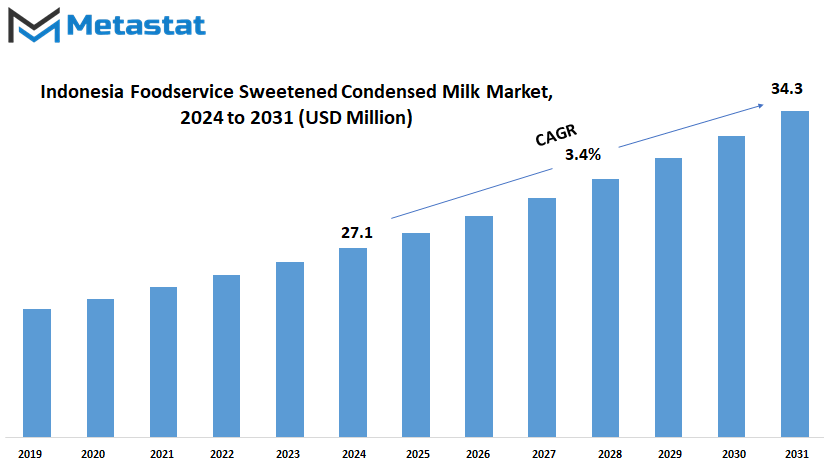
GROWTH FACTORS
Indonesia Foodservice Sweetened Condensed Milk Market is expected to grow at a significant rate through the forecast period with the presence of a number of driving factors. For instance, there is a rising demand for sweetened condensed milk in foodservice. The growing number of consumers taking their meals at restaurants and cafes has led to the development of different beverages and desserts in which the use of this condense milk is witnessing its incorporation everywhere. This product is one of the preferred ingredients in many traditional Indonesian recipes, which adds to its attraction both in restaurants and cafes. The increased demand for coffee-based drinks such as lattes and espressos, which sweetened condensed milk is widely used, also fuels demand.
Another factor fueling growth in this market is the convenience along with a long shelf life of sweetened condensed milk. Things that are easy to store, don't go bad easily, and are easy to use are paramount in a fast-paced foodservice environment. Sweetened condensed milk fills this need, making it a popular choice for many companies.
Despite this, there are few challenges that could limit the expansion of this market. There is one threat: rising health awareness among consumers. The more consumers realize how sugar overindulgence can have horrific consequences, the higher the possibility of staying away from products such as sweetened condensed milk. This may force some companies to consider healthier alternatives. Raw materials prices vagaries, especially sugar and milk, may also influence the cost and availability of sweetened condensed milk. Consequently, this will affect usage in food service operations.
Despite these limitation areas, there are possible growth areas. The sweetened condensed milk could be also developed in healthier variants-low sugar or plant-based. That is likely to attract the health-conscious consumer who would not compromise on the flavor that has put this variant on top. The growth of the food service industry, particularly in urban centers in Indonesia, is also likely to hold a certain level of demand for such a product.
The outlook for the sweetened condensed milk market of the foodservice in Indonesia appears promising. Long-term growth is channeled through adapting to shifting consumer tastes and preferences, as well as market pressures. Businesses operating in this market can expect to be on an upward trajectory with innovation and flexibility, meeting the changing needs of the consumers in the years ahead.
MARKET SEGMENTATION
By Food Service Outlet
The Indonesia Foodservice Sweetened Condensed Milk market has been growing steadily and is likely to continue its further growth process. This growth is borne by the strengthened demand from all food service outlets in the country. Among the segments, one of the major ones is cafes and coffee houses. As the culture of coffee gains increasing popularity in Indonesia, it is also seen to be growing its operations of flavoring its beverages with sweetened condensed milk in local favorites like iced coffee and other milk-based beverages. The growing momentum of the newest and most creative coffee concoctions will also continue to make this segment a key generator of market growth.
Apart from cafes and coffee shops, restaurants too seem to play a big part in demand over sweetened condensed milk, since Indonesian food often uses this ingredient either in traditional recipes and innovations of modern dishes, ready-to-eat desserts, or drinks. Restaurants wishing to meet the shifting tastes of the consumers are probably going to try experimenting using sweetened condensed milk, mixed into sauces, into some desserts, or perhaps as signature drinks. Further growth in the restaurant industry and customer experience and diversity in menus will propel the market forward.
Street vendors and kiosks would also be taken into account as an integral part of the Indonesia Foodservice Sweetened Condensed Milk market. These are outlets which offer cheap, easy food to the consumers through such popular items as pancakes, sweet drinks, or even fried snacks, usually prepared with sweetened condensed milk. A sweetened condensed milk used by street vendors as an enhancer for flavor in Indonesia's prospering street food culture will ensure the continued existence of this product in the street food market, leading to sustained demand.
Bakeries are also an imperative area of this market. Sweetened condensed milk is often used in numerous baked products, from bread to pastries. With the enhanced awareness about house-baked and artisanal baked products, the bakeries would tend towards some innovative recipes using sweetened condensed milk. This trend may enhance its usage in baked products, be it the traditional or novel baked products.
The Indonesia foodservice sweetened condensed milk market will probably keep growing over these categories due to evolving preferences among consumers and innovative applications of this versatile product in various food service outlets.
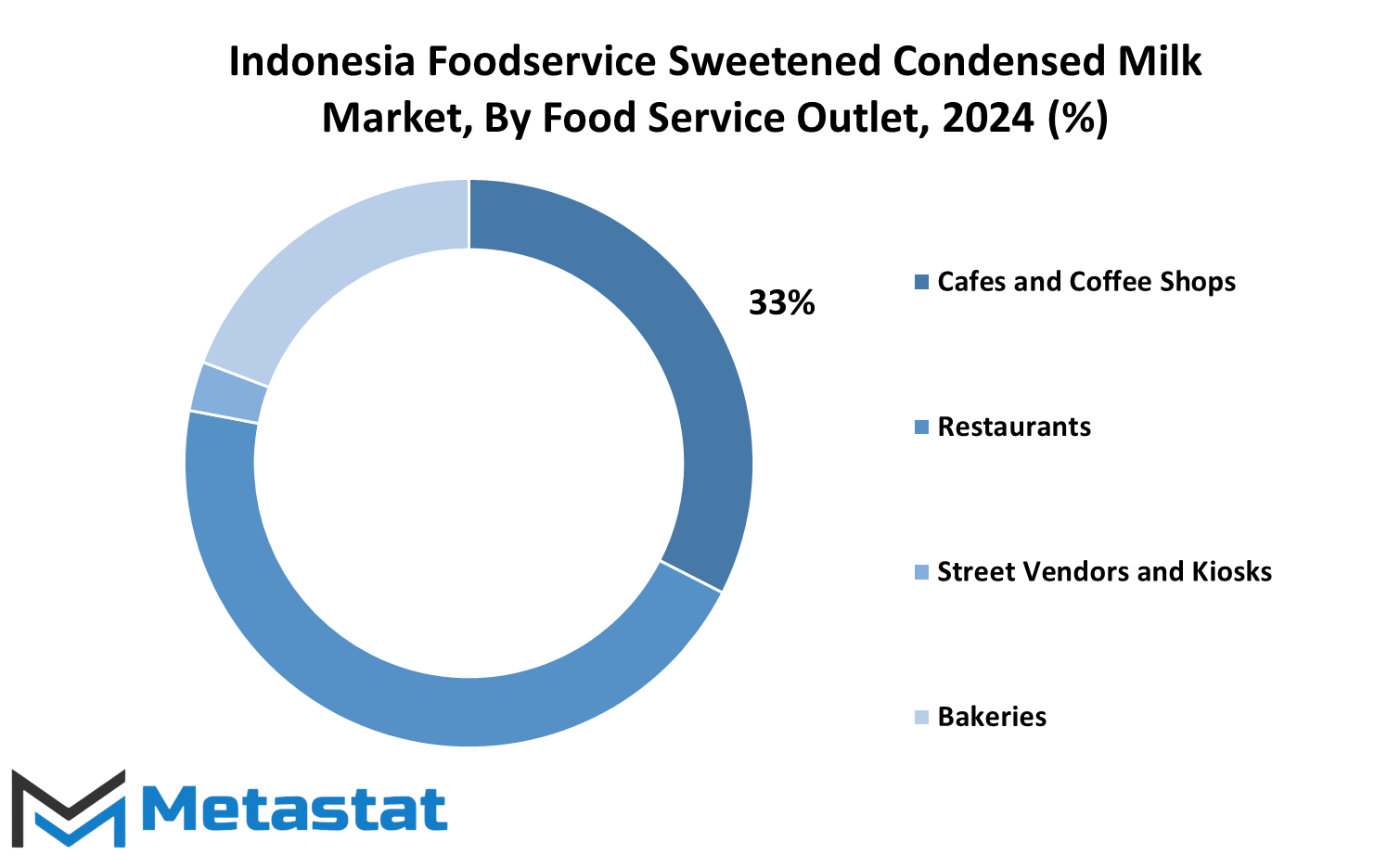
By Distribution Channel
Growth in the Indonesia Foodservice Sweetened Condensed Milk market is expected during the latter years, heavily influenced by channel distribution method. The market can be broadly segmented into three channels-direct sales, wholesalers/distributors, and retail stores; each plays a different role and fulfills a different function, and their respective influence is what is expected to drive the trajectory of the industry.
It would be efficient in terms of communicating with these foodservice establishments because direct sales provide more personalized approaches to restaurants, cafes, and bakeries. Suppliers can cut out the intermediaries and cater directly to the specific needs of such establishments regarding the supply of sweetened condensed milk. The process will, therefore become increasingly efficient as technology evolves, and they will be directly in touch with their customers through online sites and apps. This digital improvement will reduce the time it takes for there to be an order and for delivery, thus expediting the supply of businesses’ requirements.
Wholesalers and distributors also play a big role in broadening the distribution of a wide range of products within foodservice to operators. These middlemen bridge the gap between manufacturers and small firms that cannot directly interact with sales. The wholesalers enable easier accessibility for this sweetened condensed milk to small and medium-sized enterprises through buying the products in bulk and distributing them. The future of this channel may be more automation in logistics and inventory management, which will result in an efficient network of distribution. As demand increases, wholesalers must have strategies that will benefit their business through greater volumes of orders and probably a rise in more sustainable practices within their operations and for the environment.
While retail stores remain the first priority for individual customers, they are also a component of the food service sector. Many small businesses, especially newer ventures, experience periodic replenishment of stores in the retail shops whenever they need to replenish their supplies. This should continue to occur as convenience is expected to be an increasing purchase influencer across local retail stores, but possibly retail store sales needs to shift toward more e-commerce and delivery sales as e-commerce alternatives develop.
General, the Indonesia Foodservice Sweetened Condensed Milk market would change based on the performance of its channels. With the adoption of direct sales, wholesalers, and retail stores responding to the needs of modern demand, the market would grow further as satisfied by both small and large foodservice businesses.
|
Report Coverage |
Details |
|
Forecast Period |
2024-2031 |
|
Market Size in 2024 |
$27.1 Million |
|
Market Size by 2031 |
$34.8 Million |
|
Growth Rate from 2024 to 2031 |
3.4% |
|
Base Year |
2022 |
COMPETITIVE PLAYERS
Indonesia Foodservice Sweetened Condensed Milk Major contributors include growth in Frisian Flag Indonesia (FFI), Nestlé Indonesia, Indofood CBP Sukses Makmur, and PT Ultrajaya Milk Industry. A few of the participants here benefit from already established brands, wide-reaching distribution coverage, and innovation, all of which significantly contribute to future market leadership. With increased demand for sweetened condensed milk in the foodservice industry, competition among similar players shall rise.
Frisian Flag Indonesia (FFI) is one of the market leaders associated with quality and reputation over a long period of time. Hence, it is expected that FFI shall continue to expand its reach and serve the changing needs of the foodservice industry. A continuity of product development and alignment to tastes of the consumers will definitely ensure this company remains competitive in the market. Similarly, Nestlé Indonesia, with a strong brand name worldwide and a solid footing in the dairy sector, will make sure of its competencies by spending its resources to be relevant in the market. Nestle has a long history in food service products and is focused on sustainability, where they may be able to gain more customers, especially with consumer preference changing towards healthier and responsibly sourced ingredients.
The other significant company that could influence quite a bit in the future of the market is Indofood CBP Sukses Makmur. Its diversified product line and innovation in new variations of sweetened condensed milk might help it to succeed in a competitive market. Its position on delivering affordable and quality products will help the brand to attract cross-section customers from small entrepreneurs to large-scale food service operations.
PT Ultrajaya Milk Industry also has a strong market presence in the market. As consumer demand escalates, PT Ultrajaya may escalate its levels of production, subsequently ensuring regular supplies to the foodservice sector of this industry. Their investment in state-of-the-art technology and production efficiency could also place them even better in terms of competitiveness.
The Indonesia Foodservice Sweetened Condensed Milk market will have continued growth in the future. These leaders and laggards will keep investing in innovation, product development, and expansion of their distribution networks, causing this market to continue to be competitive and dynamic. It will result from catering to changing foodservice customer needs combined with each company's specific strengths defining the eventual contours of this market.
Indonesia Foodservice Sweetened Condensed Milk Market Key Segments:
By Food Service Outlet
- Cafes and Coffee Shops
- Restaurants
- Street Vendors and Kiosks
- Bakeries
By Distribution Channel
- Direct Sales
- Wholesalers/Distributors
- Retail Stores
Key Indonesia Foodservice Sweetened Condensed Milk Industry Players
WHAT REPORT PROVIDES
- Full in-depth analysis of the parent Industry
- Important changes in market and its dynamics
- Segmentation details of the market
- Former, on-going, and projected market analysis in terms of volume and value
- Assessment of niche industry developments
- Market share analysis
- Key strategies of major players
- Emerging segments and regional growth potential



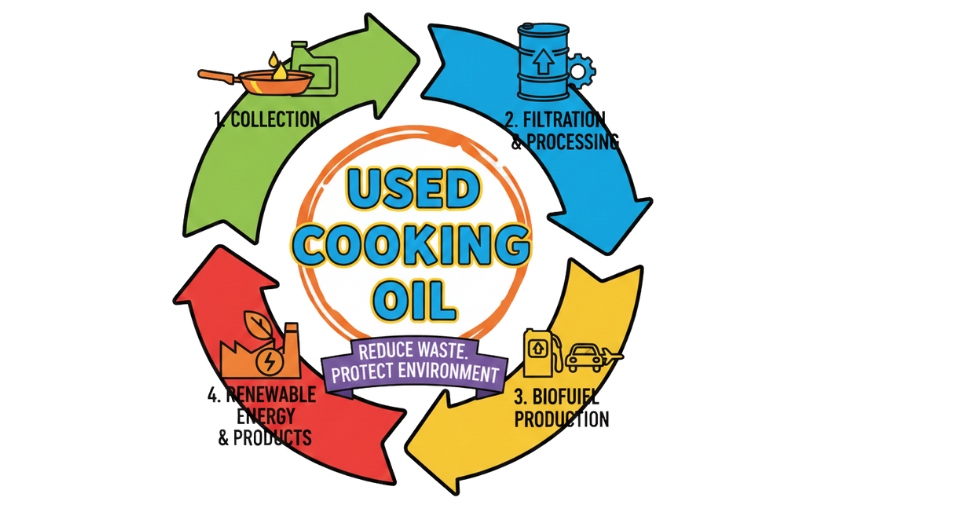
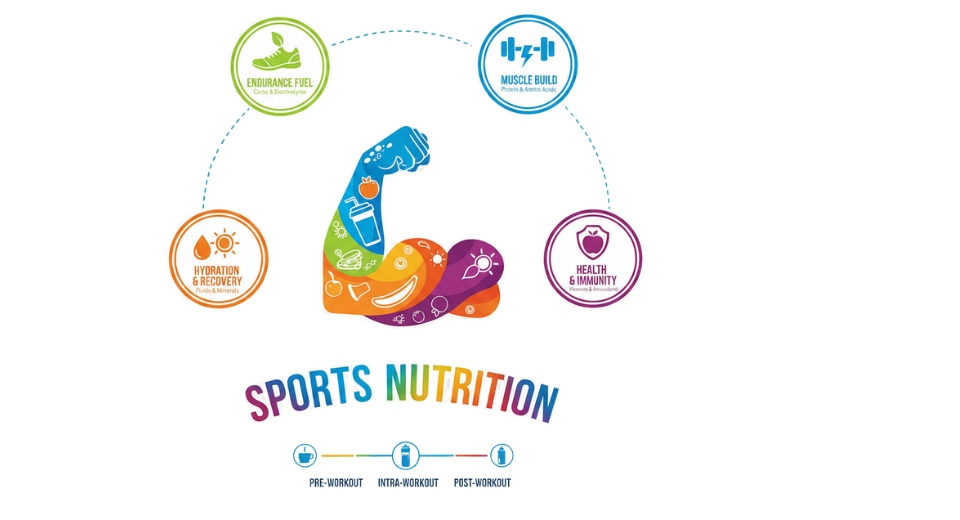
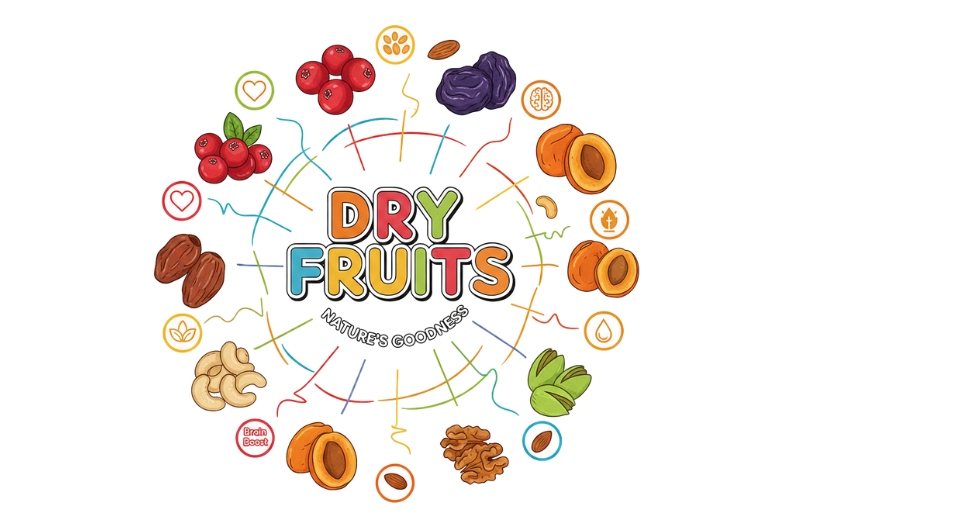


 US: +1 3023308252
US: +1 3023308252






